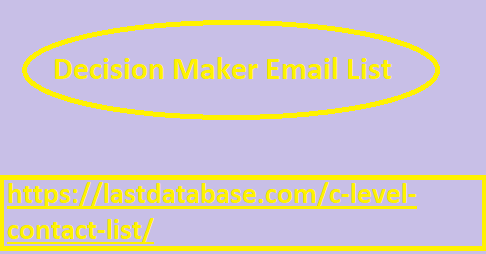Post by samuelbapary3 on Jan 15, 2024 0:15:28 GMT -6
Advertising in the digital environment has grown as a golden opportunity for advertisers to reach a broader audience and in a more selective way. However, this environment also presents a series of difficulties, such as user saturation. A study carried out by Seedtag , through MetrixLab, aims to focus on the value of the image as a potential solution for the effectiveness of online advertising. The research focuses on the use of images as advertising placement with the ability to capture users' attention, and tries to clarify the keys to the success of an advertisement with visual support compared to other formats such as video or display.
To do this, Seedtag has turned to powerful eye attention monitoring techniques, such as eye-tracking . The sample analyzed includes more than 1,000 consumers, who were exposed to the evaluation Decision Maker Email List of standard ads and In-Image ads. This technique follows the actual direction of the user's eyes, determining the hot-points of attention within the web page. This has shown that ads that appear over visual elements are viewed 3.5 times (or 3.4 seconds) faster than other display and video ads. Consequently, all visual elements defeat the rest of the elements (textual, for example) within the general content.

In addition, they maintain attention for a noticeably longer time (up to 7 times longer, in the clearest cases). Another technique used has been passive viewing tracking , which studies the emotional response. After testing, Seedtag concluded that visual ads have a greater number of positive impacts and are perceived as more pleasant and interesting. This methodology has reconsidered the effectiveness of studies based solely on viewabillity ; That is, not only the percentage of viewing an ad matters but also the time dedicated to it, the attention and the quality of the response to the message. An extension of the concept that MatrixLab has defined as “view quality.
To do this, Seedtag has turned to powerful eye attention monitoring techniques, such as eye-tracking . The sample analyzed includes more than 1,000 consumers, who were exposed to the evaluation Decision Maker Email List of standard ads and In-Image ads. This technique follows the actual direction of the user's eyes, determining the hot-points of attention within the web page. This has shown that ads that appear over visual elements are viewed 3.5 times (or 3.4 seconds) faster than other display and video ads. Consequently, all visual elements defeat the rest of the elements (textual, for example) within the general content.

In addition, they maintain attention for a noticeably longer time (up to 7 times longer, in the clearest cases). Another technique used has been passive viewing tracking , which studies the emotional response. After testing, Seedtag concluded that visual ads have a greater number of positive impacts and are perceived as more pleasant and interesting. This methodology has reconsidered the effectiveness of studies based solely on viewabillity ; That is, not only the percentage of viewing an ad matters but also the time dedicated to it, the attention and the quality of the response to the message. An extension of the concept that MatrixLab has defined as “view quality.
